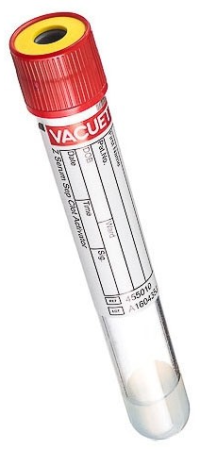
Test Code: 905
CPT Code(s): 84550
Methodology: Spectrophotometry (SP)
Clinical Significance: Serum uric acid measurements are useful in the diagnosis and treatment of numerous renal and metabolic disorders, including renal failure, gout, leukemia, psoriasis, starvation or other wasting conditions, and in patients receiving cytotoxic drugs.
Additional names: Not applicable
Supply: #T157 Red/Yellow SST 8mL
Preferred Specimen Requirements: Serum
Preferred Volume: 1mL
Container Type: Serum Separator tube (SST)
Patient Preparation: The assay manufacturer, Beckman Coulter advises: "N-acetyl cysteine (NAC), when administered in therapeutic concentrations (for the treatment of acetaminopehn overdose), has been determined to interfere with assays for cholesterol and uric acid" where "NAC interference may lead to falsely low results." According to Beckman Coulter the NAC interference should be insignificant by 12 hours after completion of the intial loading dose of an IV infusion treatment regimen consisting of an intial loading dose of 150 mg/kg administered over 1 hour, a second dose of 50 mg/kg administered over 4 hours and a third dose of 100 mg/kg administered over 16 hours.
Transport Temperature: Room Temperature
Specimen Stability: Room Temperature: 72 hours
Reject due:
- Hemolysis
- What are hemolyzed specimens?
- Hemolysis occurs when the red cells are damaged during sample collection causing them to rupture. Hemolyzed serum or plasma is pale pink to red rather than the normal clear straw or pale-yellow color.
- What causes a specimen to be hemolyzed?
- Mixing tubes too vigorously
- Placing tubes in the refrigerator without allowing 30 minutes at room temperature for complete clotting
- Exposure to heat or in a refrigerator that is too cold
- Using a needle with too small of a bore necessary for the venipuncture
- Using too large a tube when using a butterfly needle
- Not allowing sufficient time for alcohol to dry on puncture site
- Leaving the tourniquet on for longer than one minute
- How can hemolyzed specimens be prevented?
- For routine collections, use a 20–22-gauge needle
- Do not remove the needle from the vein with the vacuum tube engaged
- Do not collect a specimen in a hematoma
- Do not centrifuge the specimen for a prolonged period of time
- Draw the sample gently and evenly
- What are hemolyzed specimens?
- Specimens exceeding stability
- Specimens other than serum
- Unlabeled or improperly labeled specimens
For additional supply or collection information, please contact DLO's Customer Service at (800) 891-2917, option 2.
The CPT codes provided are based on AMA guidelines and are for informational purposes only. CPT coding is the sole responsibility of the billing party. Please direct any questions regarding coding to the payor being billed.
